Back to Tenrec Resources and Information
Remarks on the Lesser Hedgehog Tenrec (Echinops telfairi)
| by | David G. Kupitz, Viktoriastr. 3, 32257 Bünde, Germany e-mail: dk (at) tenrec.org |
General remarks:
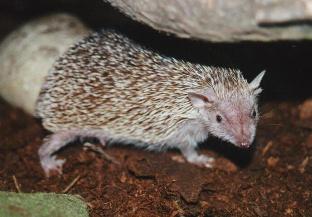 The Lesser Hedgehog Tenrec (Echinops telfairi, Martin, 1838) within the insectivore family of the tenrecs (Tenrecidae) belongs to the subfamily of "true tenrecs" or Tenrecinae (5 species), which are endemic for Madagascar. The habitat of the species is dry forest, thorny bush and gallery forest in the southwest and south of the island (Garbutt, 1999). The Malagasy call it Tambotriky or Tanibodrika, the German name is Kleiner Igeltanrek and the French petit tanrec hérisson.
The Lesser Hedgehog Tenrec (Echinops telfairi, Martin, 1838) within the insectivore family of the tenrecs (Tenrecidae) belongs to the subfamily of "true tenrecs" or Tenrecinae (5 species), which are endemic for Madagascar. The habitat of the species is dry forest, thorny bush and gallery forest in the southwest and south of the island (Garbutt, 1999). The Malagasy call it Tambotriky or Tanibodrika, the German name is Kleiner Igeltanrek and the French petit tanrec hérisson.
The Lesser Hedgehog Tenrec is apparently not yet threatened; nevertheless, Madagascar's forests are among the world's hot spots in nature destruction, which is why the entire island's fauna is in demand of special attention. Additionally, and in spite of the protected status of tenrecs in Madagascar, wild hedgehog tenrecs are still being caught either for the pot or for the pet trade, with the latter animals in most (not all!) cases ending up at inexperienced and (not necessarily purposely) ignorant keepers. [Addition March 18th, 2014: please note that Echinops telfairi is listed as "Least Concern" in the IUCN Red List - my above concerns may thus eventually have been somewhat overly cautious in this regard. DGK]
External appearance:
Echinops telfairi in its entire appearance resembles a slender miniature hedgehog; it also shares many other features with the hedgehogs (Erinaceidae), although they are only distantly related (tenrecs are about as closely related to shrews or moles as they are to hedgehogs). Therefore, hedgehogs and hedgehog tenrecs are considered a classical example of convergent evolution (Gould & Eisenberg, 1966).
They are approximately 14-18 cm large and weigh between 110 and 230 g, depending on nutritional situation and season (Garbutt, 1999). Except for the face and the ventral side the animals are covered with relatively long, not very dense quills, which are not as pointed as those of the European Hedgehog (Erinaceus europaeus). The quill color can vary from a very pale, almost whitish shade to dark grey; the underside is light grey or whitish. Many animals show flanks that are lighter than the upper side on which frequently a broad vague stripe runs. These color variations also occur in one and the same litter and are no sign for a subspecies.
Behavior:
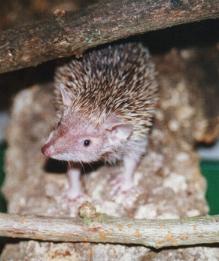 The Lesser Hedgehog Tenrec is a nocturnal insect hunter. In captivity the animals often already emerge from their hiding spot in the early evening and start foraging. Characteristic for these tenrecs is their very unstable ability to thermoregulate, which affects their entire annual cycle and is a fact that should be considered when keeping the animals in captivity. During the Austral winter (around May-September), which is markedly dry (= lack of prey) and cool, Echinops is in a state of torpor; it is lethargic and eats and drinks only seldomly.
The Lesser Hedgehog Tenrec is a nocturnal insect hunter. In captivity the animals often already emerge from their hiding spot in the early evening and start foraging. Characteristic for these tenrecs is their very unstable ability to thermoregulate, which affects their entire annual cycle and is a fact that should be considered when keeping the animals in captivity. During the Austral winter (around May-September), which is markedly dry (= lack of prey) and cool, Echinops is in a state of torpor; it is lethargic and eats and drinks only seldomly.
In captivity the Lesser Hedgehog Tenrec exhibits a certain social tolerance, meaning that sometimes even several pairs can be kept together. In most cases, though, two males do not get along and fight. Females can be kept together without problems for the most part. Towards humans, the animals are mostly relatively friendly and bite only when the hand has been in contact with food prior to approaching the tenrec. Even during the lactation period I did not observe any increase in aggressiveness which has been reported in the literature. When disturbed or startled, the animals erect their quills (particularly on the head), emit a sound that is hard to explain, or curl up like hedgehogs.
The animals are semi-arboreal and accordingly climb very well, though rather slowly. Occasionally they will hang from a branch with only one foot or even one claw attached and still manage to attain an upright position again.
An interesting behavior is the self-anointing or "scent-marking", which is carried out after cage cleaning, introduction of new objects in the cage, or also on a human body. Saliva is spread on the substrate and on the animal's flanks using the front paws. The exact purpose of this behavior is still not clear.
Housing:
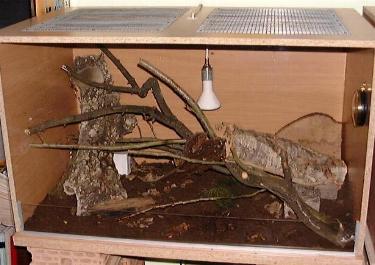 A wooden or glass terrarium - as large as possible and having openings on the top for circulation - is recommendable. I keep my tenrec in cages of varying sizes with are modelled after the construction method of Gerrits (1997a), but are altered in some ways.
A wooden or glass terrarium - as large as possible and having openings on the top for circulation - is recommendable. I keep my tenrec in cages of varying sizes with are modelled after the construction method of Gerrits (1997a), but are altered in some ways.
The cages are essentially boxes made of plastic-coated plywood (16 mm) and open at the front side, which are being held together by wooden pegs. The lid is also plywood and is easy to open through the use of hinges. The lid has two large wire-covered circulation openings which leave only a narrow edge and a small bridge in the middle. An Elstein heat lamp (60 or 180 Watt) is fastened to the "bridge" can be adjusted by lowering the cable (watch out for enough distance to branches and animals).
The front side is an acrylic glass pane (8 mm), whose underside rests in a U-shaped rail. It is held in place by two movable metal clamps which are attached to the terrarium sides. The method of building makes it possible to slide the pane to the side, as well as take it out completely and easily. On the inside of the pane another small pane (10 cm tall) is fastened to the cage walls. This prevents substrate to get out of the cage when the front door is opened.
The cracks and corners of the cage are sealed with aquarium silicon.
My terrariums have the dimensions 100 x 60 x 60 cm, 90 x 65 x 50 cm and 70 x 60 x 60 cm. Besides floor area, the height of the cages is also important because the animals like to climb.
Cage furnishings:
The substrate consists of peat or a peat-soil mixture. Commercially available small mammal substrate made of wood shavings are often accidentally ingested by the tenrecs, because the shavings stick to moist food or insects. To avoid problems, I use peat. It is also easier to hide prey animals such as mealworms, earthworms or rose-chafer larvae, which adds to the tenrecs' enrichment. In addition I offer dry leaves, hay, straw, moss and tissues, all of which are used by females with young for nest construction.
According to the preference of Echinops telfairi for climbing the cages are richly furnished with branches, stones, cork bark and other pieces of wood, which are used willingly used by the animals and also provide additional hiding options. Additionally, some cages have meshwire-strips fixed to the cage sides which the tenrecs also use to climb (see also Gerrits, 1997a; Künzle, 1998).
Apparently the Lesser Hedgehog Tenrec is not very picky when it comes to hide-outs; the literature and other keepers have reported various different designs. I provide different nesting boxes, among them home-made boxes similar to those of Künzle (pers. comm.) made of plastified plywood (8 mm) which have the size 19 x 12 x 12 cm and a hinge-attached lid. This is very helpful for regular control during torpor and the raising of young. Shoe boxes of different sizes and bark or stone cavities are also used.
I clean the terrarium - depending on the activity of the tenrecs - weekly to monthly, which is absolutely sufficient in winter because the metabolism works on a very low level. When the animals are in torpor the nest box should not be cleaned to not wake them up unnecessarily.
Nutrition:
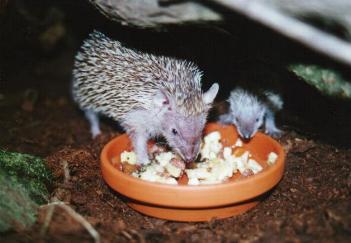 The animals predominantly, though not exclusively, are carnivores. I feed a varied mixture of prepared diet, live food and plant matter. The animal part of the diet accounts for about 80-90% of the total amount. I offer canned and dry food for cats, canned hedgehog diet, dog sausage, yogurt, and occasionally hard-boiled egg. Live food consists of crickets, locust and grasshoppers, cockroaches, mealbeetles and their larvae, Zophobas, earthworms, slugs, small snails, rose-chafer larvae, wax moth larvae and isopodes. Stick insects, nest mice and day-old chicks can also be fed. As plant matter in the diet, sweet fruit such as bananas or kiwi is particularly popular, but not with all animals. Additional food can be cooked rice, white bread in milk and chopped garlic.
The animals predominantly, though not exclusively, are carnivores. I feed a varied mixture of prepared diet, live food and plant matter. The animal part of the diet accounts for about 80-90% of the total amount. I offer canned and dry food for cats, canned hedgehog diet, dog sausage, yogurt, and occasionally hard-boiled egg. Live food consists of crickets, locust and grasshoppers, cockroaches, mealbeetles and their larvae, Zophobas, earthworms, slugs, small snails, rose-chafer larvae, wax moth larvae and isopodes. Stick insects, nest mice and day-old chicks can also be fed. As plant matter in the diet, sweet fruit such as bananas or kiwi is particularly popular, but not with all animals. Additional food can be cooked rice, white bread in milk and chopped garlic.
The preference for different foods varies individually and from time to time. During pregnancy and lactation, females will eat almost anything, including fruit, which is not touched by some animals. Young animals are less picky as well.
In general, Lesser Hedgehog Tenrecs are inclined to become obese. Because of this, special attention should be given to the amount of food. Beginners are advised to feed carefully and monitor the animals' weight to achieve gradual certainty in estimating the best amount of food. Young animals, however, should be provided with sufficient amounts for their growth.
The food is enriched by adding Gistocal or Vitakalk, and live food is also dusted with this.
Annual cycle:
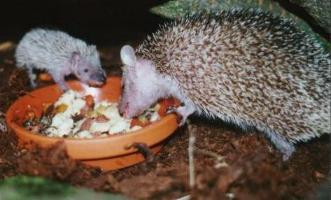 The activity rhythm of the Lesser Hedgehog Tenrec is partly controlled endogenously, nevertheless external factors should be taken into account in captivity to provide nature-like conditions and to "facilitate" the resting season. The effects on reproduction are not yet known, but it is assumed that winter rest is significant for successful breeding (Gerrits, 1997a; Godfrey & Oliver, 1978).
The activity rhythm of the Lesser Hedgehog Tenrec is partly controlled endogenously, nevertheless external factors should be taken into account in captivity to provide nature-like conditions and to "facilitate" the resting season. The effects on reproduction are not yet known, but it is assumed that winter rest is significant for successful breeding (Gerrits, 1997a; Godfrey & Oliver, 1978).
In November, the cage temperature is slowly lowered to approximately 17-20°C. This is done by the natural seasonal lowering of the outside temperature, and also by exchanging the 180 Watt lamps by 60 Watt lamps and by increasing distance between lamp and cage floor. I gradually reduce the amount of food until the animals only get something every or every other week. The tenrecs become lethargic, eat less and eventually retire to a hide-out completely. More than one female can be over-wintered together (also with one male), but the effects on breeding potential of mixed-sex over-wintering are unknown. It is much easier though to separate the animals in smaller containers (e.g. a large enough transport box) during torpor.
After 2-4 months, the hedgehog tenrecs either start by themselves to become more active again, or I raise the temperature over one or two weeks again to make them do this. Some individuals react slower to the increased temperatures than others, this is normally no reason to worry.
During the season of activity, the Elstein lamps heat the terrarium up to about 23-32°C, depending on proximity to the lamp. Because of the temperature gradient, the tenrecs can choose their favorite temperature in the terrarium. During this time of year I spray the terrarium several times per week with a flower sprayer to increase humidity. This is not done during over-wintering.
Breeding:
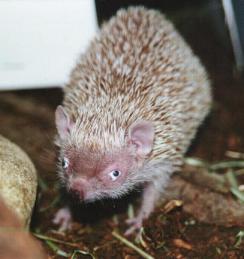 After the winter rest and a couple weeks of acclimatisation time, the animals are combined in pairs (or 1.2 animals), which usually is followed by immediate mating attempts. Males often show a milky white liquid discharging from eye or nose; the reason for this behavior is as yet unknown. During mating, which can last longer than an hour, the female mostly squeaks and the male puffs from time to time. The frequency of mating attempts decreases after several weeks, after which I separate the animals again.
After the winter rest and a couple weeks of acclimatisation time, the animals are combined in pairs (or 1.2 animals), which usually is followed by immediate mating attempts. Males often show a milky white liquid discharging from eye or nose; the reason for this behavior is as yet unknown. During mating, which can last longer than an hour, the female mostly squeaks and the male puffs from time to time. The frequency of mating attempts decreases after several weeks, after which I separate the animals again.
1-10, on average 3-6, young are born after a gestation of around 60 to 65 days (Künzle, 1998, reports at least one proven gestation of 52 or less days). One of my females gave birth to 7 young 66 days after being introduced to a male; it is assumed, however, that the females show an induced ovulation, so a few days would have to be subtracted from this gestation. The pregnancy of a female becomes obvious through increased body weight, swelling of the abdomen and (shortly before birth) the teats, particular interest in food and nest building.
Hand-rearing is possible (e.g. when the mother died), good descriptions can be found in Taynton (1979) and Gerrits (1997b). It can be argued though, that the young would be lost in nature anyway and that a natural selection should take place in captivity, too.
Development:
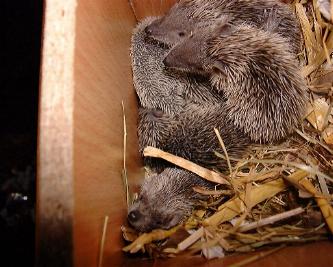 At birth the young weigh about 5-10 g, the quill tips are under the skin, the eyes and ears are closed. The speed of development depends very much on the size of the litter, but also on the individual, and the literature gives greatly varying data. I will only try to provide some basic numbers. After a few days already the young are covered with quills, the eyes open around day 9. About a week later (or a little earlier) they start to leave the nest temporarily. At 3 weeks the first of the young start to take in solid food, at 4 weeks at the latest all young eat solid food. At this time it is especially important to provide a varied diet.
At birth the young weigh about 5-10 g, the quill tips are under the skin, the eyes and ears are closed. The speed of development depends very much on the size of the litter, but also on the individual, and the literature gives greatly varying data. I will only try to provide some basic numbers. After a few days already the young are covered with quills, the eyes open around day 9. About a week later (or a little earlier) they start to leave the nest temporarily. At 3 weeks the first of the young start to take in solid food, at 4 weeks at the latest all young eat solid food. At this time it is especially important to provide a varied diet.
At the age of about 35 days the young do not get milk from their mother any longer. At this time it is also possible to separate them, but one can also leave them with the mother longer and (in the case of females) constantly. Weight curves are given in Godfrey & Oliver (1978) and in Honegger & Noth (1966), amongst others. After their first over-wintering the animals are sexually mature. They can reproduce until at least the age of 7.
The young are hard to sex before their first torpid period because of their cloaca. Males are characterized by enlarged rings around the eyes, which are caused by eye glands. Adult females often show clearly visible teats. Unsexed animals can be paired with a male - the reaction (copulation or aggression) often shows the sex. Males also have a distinct odor, which can be recognized with a bit of experience.
The Lesser Hedgehog Tenrec has a relatively long life-span, and the oldest animal I know lives in an American zoo and is 17. This is not usual of course, an age of 6-9 years is probably the average.
Diseases:
In old age some animals suffer from jaw abscesses which are difficult to cure (Gerrits, 1997b). As a prevention hard food (dry cat food, hard-armoured insects) might be helpful. Gerrits (1997b) also reports airway infections which sometimes in an early stage could be treated with antibiotics. To prevent deficiencies and deformities in young animals, special attention should be given to the supply of the female with minerals and vitamins during pregnancy and lactation.
References:
EISENBERG, J. F. (1975): Tenrecs and solenodons in captivity. Int. Zoo Ybk. 15: 6-12. (Full Text)
- (1980): Insectivorous mammals in captivity. Int. Zoo Ybk. 20: 47-52.
EISENBERG, J. F. & GOULD, E. (1967): The maintenance of tenrecoid insectivores in captivity. Int. Zoo Ybk. 7: 194-196. (Full Text)
- (1970): The Tenrecs: A Study in Mammalian Behavior and Evolution. Smiths. Contrib. to Zool. 27. 138 pp. (Full Text)
EISENBERG, J. F. & MUCKENHIRN, N. (1968): The reproduction and rearing of tenrecoid insectivores in captivity. Int. Zoo Ybk. 8: 106-110. (Full Text)
GARBUTT, N. (1999): Mammals of Madagascar. Yale University Press, New Haven and London.
GERRITS, D. N. (1997a): Keeping and Breeding the Lesser Hedgehog Tenrec (Echinops telfairi). Haltung und Zucht des Kleinen Igeltanreks (Echinops telfairi). Mitteil. der Bundesarbeitsgruppe (BAG) Kleinsäuger 2/97: 3-4. (Full Text)
- (1997b): Experiences with keeping and breeding the Small Madagascar Hedgehog Tenrec (Echinops telfairi). Erfahrungen mit der Haltung und Zucht des Kleinen Igeltanreks (Echinops telfairi). Unpublished. (Full Text)
GODFREY, G. K. & OLIVER, W. L. R. (1978): The reproduction and development of the pigmy hedgehog tenrec Echinops telfairi. Dodo, J. Jersey Wildl. Preserv. Trust 15: 38-51. (Full Text)
GOULD, E. & EISENBERG, J. F. (1966): Notes on the biology of the Tenrecidae. J. Mamm. 47 (4): 660-686. (Full Text)
HONEGGER, R. E. & NOTH, W. (1966): Beobachtungen bei der Aufzucht von Igeltanreks Echinops telfairi Martin. Zool. Beiträge (N.F.) 12 (2): 191-218.
HERTER, K. (1963): Untersuchungen an lebenden Borstenigeln (Tenrecinae). 2. Über das Verhalten und die Lebensweise des Igeltanreks Echinops telfairi Martin in Gefangenschaft. Zool. Beiträge (N.F.) 8 (1): 125-165.
KÜNZLE, H. (1998): Care and breeding of the Madagascan hedgehog tenrec, Echinops telfairi, under laboratory conditions. Der Tierschutzbeauftragte 1/98: 5-12; 2/98: 113-115. (Full Text)
RIORDAN, D. V. (1972): Reproduction in the spiny hedgehog tenrec Setifer setosus and the pigmy hedgehog tenrec Echinops telfairi. Jersey Wildl. Preserv. Trust Ann. Rep. 9: 18-25.
TAYNTON, K. M. (1979): Handrearing pigmy hedgehog tenrec Echinops telfairi at the Jersey Wildlife Preservation Trust. Dodo, J. Jersey Wildl. Preserv. Trust 16: 64-69. (Full Text)
Dr. David G. Kupitz, Viktoriastr. 3, 32257 Bünde, Germany, e-mail: dk (at) tenrec.org